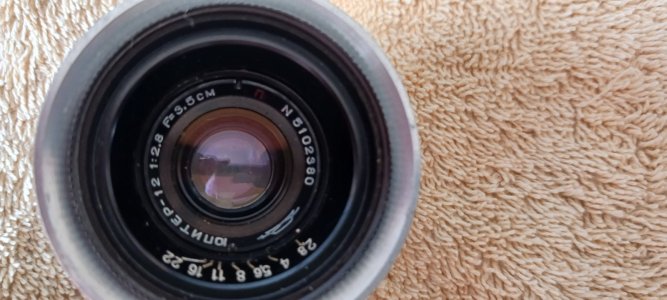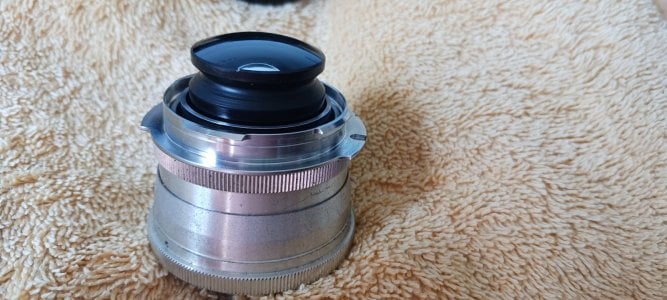I am seeing a lot of normal production Jupiter lenses on Ebay being advertised as ZK Sonnars and BK Biogons. Someone in Russia must be making Name Rings with ZK and BK inscribed, with serial numbers and markings to fool potential buyers. These lenses are going at a premium. Sellers used to put phony Carl Zeiss Jena name rings on Jupiters and try to sell them as Sonnars. Showing them as ZK and BK lenses- probably easier, as there is not as much documentation on differentiating them from authentic lenses.
We'll start with my 1952 Jupiter-12, which is a Carl Zeiss Jena Biogon from 1943.
Early coated CZJ 3.5cm F2.8 Biogon on the Left, my $50 J-12 on the right.

It's in the book- the Serial Number is stamped on the rear element and is visible with the rear lens cap off.

Also note the thicker focus ring on the early J-12, the later lenses -that I have seen marked BK- have the thinner ring of the later J-12.
If a lens is being advertised as a BK Biogon and does not have the Serial Number on the rear group being displayed, DO NOT buy it- it is a later Jupiter-12. IF it is a Jupiter-12, and HAS the SN like mine- Grab it. It has Zeiss optics. This 1952 J-12 is as good as the Coated Biogon shown alongside of it.
We'll start with my 1952 Jupiter-12, which is a Carl Zeiss Jena Biogon from 1943.
Early coated CZJ 3.5cm F2.8 Biogon on the Left, my $50 J-12 on the right.

It's in the book- the Serial Number is stamped on the rear element and is visible with the rear lens cap off.

Also note the thicker focus ring on the early J-12, the later lenses -that I have seen marked BK- have the thinner ring of the later J-12.
If a lens is being advertised as a BK Biogon and does not have the Serial Number on the rear group being displayed, DO NOT buy it- it is a later Jupiter-12. IF it is a Jupiter-12, and HAS the SN like mine- Grab it. It has Zeiss optics. This 1952 J-12 is as good as the Coated Biogon shown alongside of it.
The ZK has Zeiss Serial Numbers on the rear fixture- the barrel must be unscrewed from the focus mount.

Mine is "in the book", and is in the same batch as my wartime Sonnar.
There are several external features that make the authentic ZK easy to identify.
Ears on the Aperture ring, same as very early Jupiter-3's.

The extra screw in the focus mount- is the stop-screw that controls focus throw, it moves in a ridge in the focus mount.

The Set Screw that holds the focus mechanism into the mount.

Zeiss, ZK, and KMZ focus mounts all use 1 set screw. Sometimes- you must remove the focus ring to uncover it. Later Jupiter-3 use 3 set screws for this function, all under the focus ring.
The barrel is an Alloy, not aluminum. You will see alloy barrels used up until about 1952 on J-3's.

The original Zeiss lenses have set screws holding the rear group in place, and the name ring in place. This ZK- has a hole tapped to put a set screw in, but it never was used.
Digging in deeper- taking the focus mechanism out of the mount,

Zeiss LTM focus mounts have their own serial numbers. The numbers for all three parts match.
I have remounted Contax ZK lenses and early Jupiter-3's into later Jupiter-3 focus mounts. So there are "Hybrids" out there. Easy to spot. The Wartime Sonnars are the sharpest that I've used, up to the modern C-Sonnar.

Mine is "in the book", and is in the same batch as my wartime Sonnar.
There are several external features that make the authentic ZK easy to identify.
Ears on the Aperture ring, same as very early Jupiter-3's.

The extra screw in the focus mount- is the stop-screw that controls focus throw, it moves in a ridge in the focus mount.

The Set Screw that holds the focus mechanism into the mount.

Zeiss, ZK, and KMZ focus mounts all use 1 set screw. Sometimes- you must remove the focus ring to uncover it. Later Jupiter-3 use 3 set screws for this function, all under the focus ring.
The barrel is an Alloy, not aluminum. You will see alloy barrels used up until about 1952 on J-3's.

The original Zeiss lenses have set screws holding the rear group in place, and the name ring in place. This ZK- has a hole tapped to put a set screw in, but it never was used.
Digging in deeper- taking the focus mechanism out of the mount,

Zeiss LTM focus mounts have their own serial numbers. The numbers for all three parts match.
I have remounted Contax ZK lenses and early Jupiter-3's into later Jupiter-3 focus mounts. So there are "Hybrids" out there. Easy to spot. The Wartime Sonnars are the sharpest that I've used, up to the modern C-Sonnar.
stoutstuff
Established
Great information Brian! I've been trolling for a Jupiter 12 and came to the conclusion that I didn't know didly of what to look for. Thank you!




I bought a later 1960 J-12 off Ebay dirt-cheap, it was missing the front element. I had a spare from the correct manufacturer and time period.
The 1952 KMZ on the left, Zeiss optics. 1960 LZOS on the right.
Looking closely: the rear group is a different shape between the two, the KMZ rear most element is thinner. The J-12 was reformulated when the German glass ran out.
The focus ring on the KMZ is wider, note the distance from the set screws. The Phony BK 3.5cm F2.8 on Ebay looks like the later lens.
Also note: some J-12's in LTM have a collar around the rear group, like the original Biogon. I have seen this collar cause problems when mounting on cameras. Try to find a lens with an exposed rear group, as shown here. The collar will not be a problem on Contax/Kiev J-12 lenses mounted on a Contax, Kiev, or Nikon RF.
KoNickon
Nick Merritt
Were pictures attached? Apparently so but I don't see them. Maybe a glitch with the new site? (or user error on my part)
What are ZK and BK? ZK = Zeiss Kiev?
What are ZK and BK? ZK = Zeiss Kiev?
I am linking to images in IMGBB.com
https://ibb.co/album/b5P3wD
http://www.sovietcams.com/index90d0.html?tmpl_into=middle&tmpl_id=464&_m_e_id=5&_menu_i_id=452
ZK is engraved in the name ring of Zeiss Sonnars that were assembled in the KMZ plant. These are the forerunner of the J-3.
"ZK" ("Sonnar Kransogorsk")
BK is engraved in the namering of 3.5cm F2.8 Biogons assembled in Russia from Zeiss components, the fore-runner of the J-12.
"BK" ("Biogon Kransogorsk")
https://ibb.co/album/b5P3wD
http://www.sovietcams.com/index90d0.html?tmpl_into=middle&tmpl_id=464&_m_e_id=5&_menu_i_id=452
ZK is engraved in the name ring of Zeiss Sonnars that were assembled in the KMZ plant. These are the forerunner of the J-3.
"ZK" ("Sonnar Kransogorsk")
BK is engraved in the namering of 3.5cm F2.8 Biogons assembled in Russia from Zeiss components, the fore-runner of the J-12.
"BK" ("Biogon Kransogorsk")
deltapuppy
Member
I had this e-bay purchase refreshed (full CLA) by a shop in Ukraine - before and after pics here. Would love any comment re originality! Based on the serial it seems to be one of the last of the reparations pieces in 1950.
Attachments
-
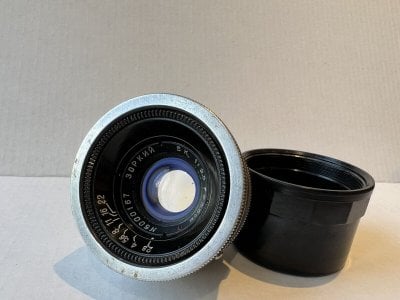 1950 BK 1.jpeg236.7 KB · Views: 22
1950 BK 1.jpeg236.7 KB · Views: 22 -
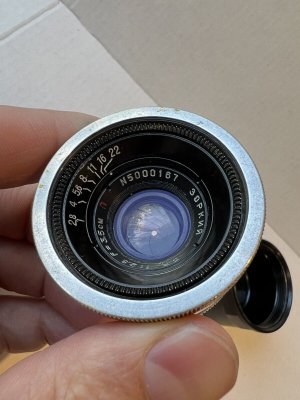 1950 bk 2.jpeg244.3 KB · Views: 22
1950 bk 2.jpeg244.3 KB · Views: 22 -
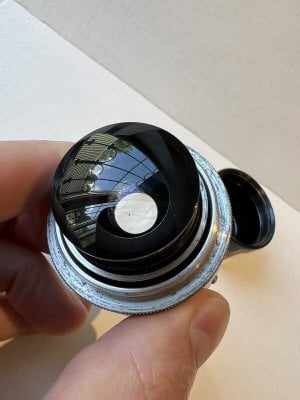 1950 bk 3.jpeg210.8 KB · Views: 19
1950 bk 3.jpeg210.8 KB · Views: 19 -
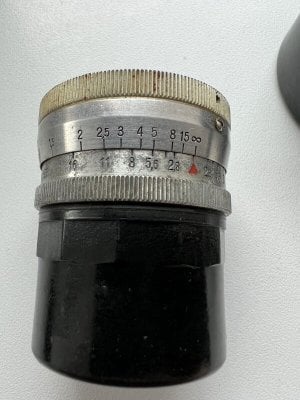 950 bk 4.jpeg312.8 KB · Views: 16
950 bk 4.jpeg312.8 KB · Views: 16 -
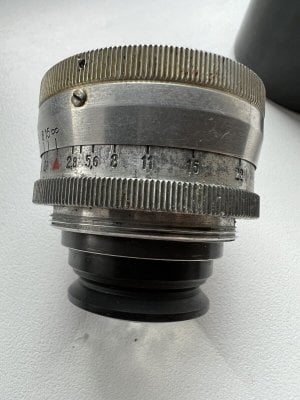 950 bk 5.jpeg292.2 KB · Views: 17
950 bk 5.jpeg292.2 KB · Views: 17 -
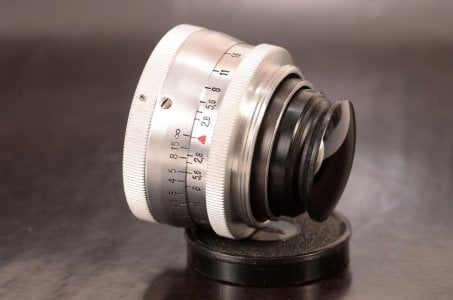 bk new 1.jpg447 KB · Views: 19
bk new 1.jpg447 KB · Views: 19 -
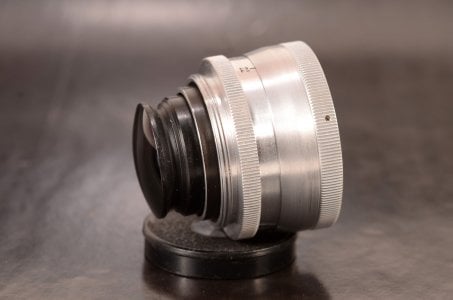 bk new 2.jpg399.1 KB · Views: 19
bk new 2.jpg399.1 KB · Views: 19 -
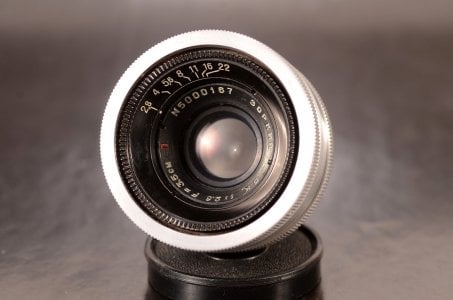 bk new 3.jpg458.9 KB · Views: 19
bk new 3.jpg458.9 KB · Views: 19 -
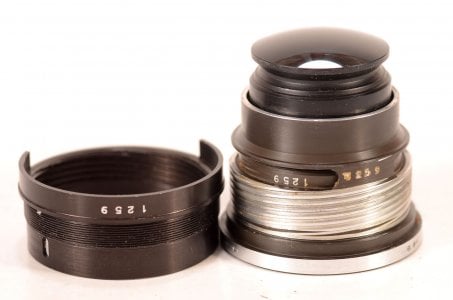 bk new 4.jpg425.2 KB · Views: 22
bk new 4.jpg425.2 KB · Views: 22
That looks authentic to me: A Zeiss Biogon completed in Russia. I have seen a couple like it. One of those: the rear group jammed against the RF follower in a Canon III. It was a bit earlier. My 1952 J-12 has Zeiss serial numbers, works perfectly on the Leica M9- I suspect they worked the kinks out.
If you use the lens- please post some pictures taken with it.
If you use the lens- please post some pictures taken with it.
deltapuppy
Member
Thank you for the reassurance! I have passed on any number of sketchy "rare" pieces on e-Bay and been watching for a good one for 3 years.I will absolutley post some pics. I plan to use it on a Zorki 4K until I get a Zorki 3. I am curious about the book you referenced - are the numbers on my copy listed somewhere? What document is that?That looks authentic to me: A Zeiss Biogon completed in Russia. I have seen a couple like it. One of those: the rear group jammed against the RF follower in a Canon III. It was a bit earlier. My 1952 J-12 has Zeiss serial numbers, works perfectly on the Leica M9- I suspect they worked the kinks out.
If you use the lens- please post some pictures taken with it.
On my 1952 KMZ J-12, there are the last digits of the Sn stamped in the collar of the rear group. You can see them on the first picture in this thread. These relate it to a batch of Biogon lenses documented in Thiele's book on Carl Zeiss Jena. The internal numbers that you show were not documented, but were used by Zeiss to match pieces of the Helical. Nikon also gave separate seiian numbers to focus mounts early in their production- I have a collapsible Nikkor 5cm F2 with a SN for the Barrel and a different one for the mount.
When the lens comes in- look for a 5 or 6 digit number on the rear of the lens.
When the lens comes in- look for a 5 or 6 digit number on the rear of the lens.
Did I put my Jupiter joke in yet?
Do you know why the Russians completed these Zeiss 3.5cm F2.8 lenses as Jupiter-12s?
They could not let Biogons be Biogons...
Do you know why the Russians completed these Zeiss 3.5cm F2.8 lenses as Jupiter-12s?
They could not let Biogons be Biogons...
Last edited:
dexdog
Mentor
deltapuppy, congratulations on the BK, an authentic one is hard to find. I have been looking for a while myself, and have not seen one yet that I was sufficiently confident enough to buy. Either that or the lens elements were trashed. By the way, the WW2 era CZJ Biogons in M39 mount look exactly like your 1950 J-12
Last edited:
deltapuppy
Member
Thank you, Dexdog. Your further confirmation is again reassuring. My hope is that this lens and comments here can join an informal online body of legit inquiry, experience and example that helps counter some of the misleading or openly fraudulent listings. I'll post a further pic if there is an actual serial number on the collar as Sonnar Brian mentioned.deltapuppy, congratulations on the BK, an authentic one is hard to find. I have been looking for a while myself, and have not seen one yet that I was sufficiently confident enough to buy. Either that or the lens elements were trashed. By the way, the WW2 era CZJ Biogons in M39 mount look exactly like your 1950 J-12
deltapuppy
Member
Thank you Brian. That's a critical distinction I wasn't aware of, the helical production numbering as opposed to a final serial #. I will look for and post pics of the collar stamping if it's present! Love the joke too!On my 1952 KMZ J-12, there are the last digits of the Sn stamped in the collar of the rear group. You can see them on the first picture in this thread. These relate it to a batch of Biogon lenses documented in Thiele's book on Carl Zeiss Jena. The internal numbers that you show were not documented, but were used by Zeiss to match pieces of the Helical. Nikon also gave separate seiian numbers to focus mounts early in their production- I have a collapsible Nikkor 5cm F2 with a SN for the Barrel and a different one for the mount.
When the lens comes in- look for a 5 or 6 digit number on the rear of the lens.
dexdog
Mentor
i have 1950 and 1951 J-12s in M39, but mine do not have czj serials on the rear lens groups. Both lenses are very clean and work well, so i have reluctant to take them apart to look for part numbers on the helicals of the optics block. i have taken apart a couple of biogons to remove sand and fossilized grease, took me a few hors to get back together correctly, several failures along the way. i think you will really like the lens.
boojum
Mentor
I have a '51 KMZ J-12 which has been described as a CZJ guts and glass KMZ. I do not use it much, usually opting for a Canon f/2.0 35mm LTM (Black) instead. I have been offered the opportunity for an expert to examine and tweak anything needed. On the APSC Pixii this would translate as a "long" 50mm (52.5mm). Yes, it does work on the Pixii, I just checked. It's a good lens. Is it a perfect lens? No. There are not a lot of perfect lenses around for $100 - $200. Anyway, here is what this '51 looks like:
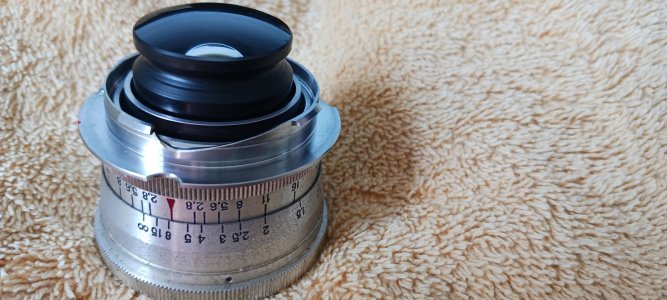
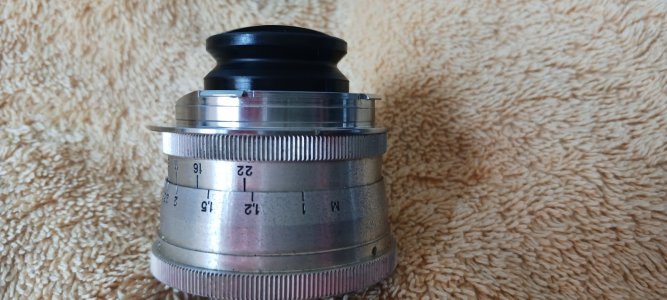


The early KMZ Jupiters are the best. Sometimes needs adjustment, but always worth it.
wlewisiii
Just another hotel clerk
That's a pretty one. I have a 1970 Lzos marked one that I bought from a polish seller who claimed he adjusted it for Leica. Don't know if he actually did anything or not but I will say it's the finest LTM J-12 I've ever gotten my hands on and I've used a few from mid 60's to the end. It would be nice to get an early KMZ one like Boojum's to compare someday.
boojum
Mentor
All I know about Jupiters, and Russian lenses in general, I learned on RFF and mostly from Brian. The other thing I have followed is to buy, as indicated, the early KMZ's which look good, are from a seller with a good, 98.5% or better rating, and be willing to pay a little extra. Better to pay it extra than get saddled with CLA and repair after. I have mostly done business with Ukraine but got a sweet Jupiter-9 from Turkey from a really fun seller who also found me some ibriks, really cezves, for coffee preparation. He was a swell guy to do business with, the lens was as he said t was and it was a fair price. In short, do not try to screw the seller.
Share:
-
This site uses cookies to help personalise content, tailor your experience and to keep you logged in if you register.
By continuing to use this site, you are consenting to our use of cookies.






